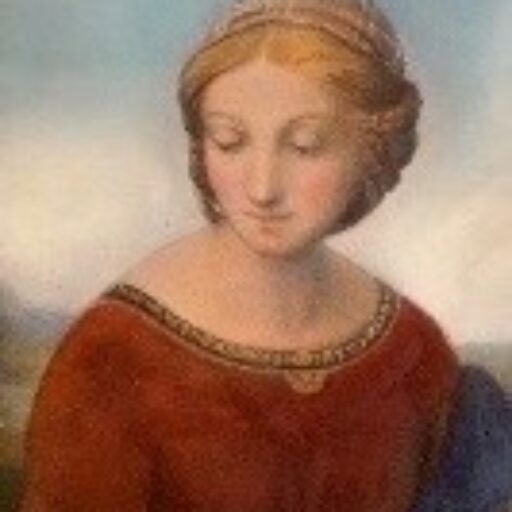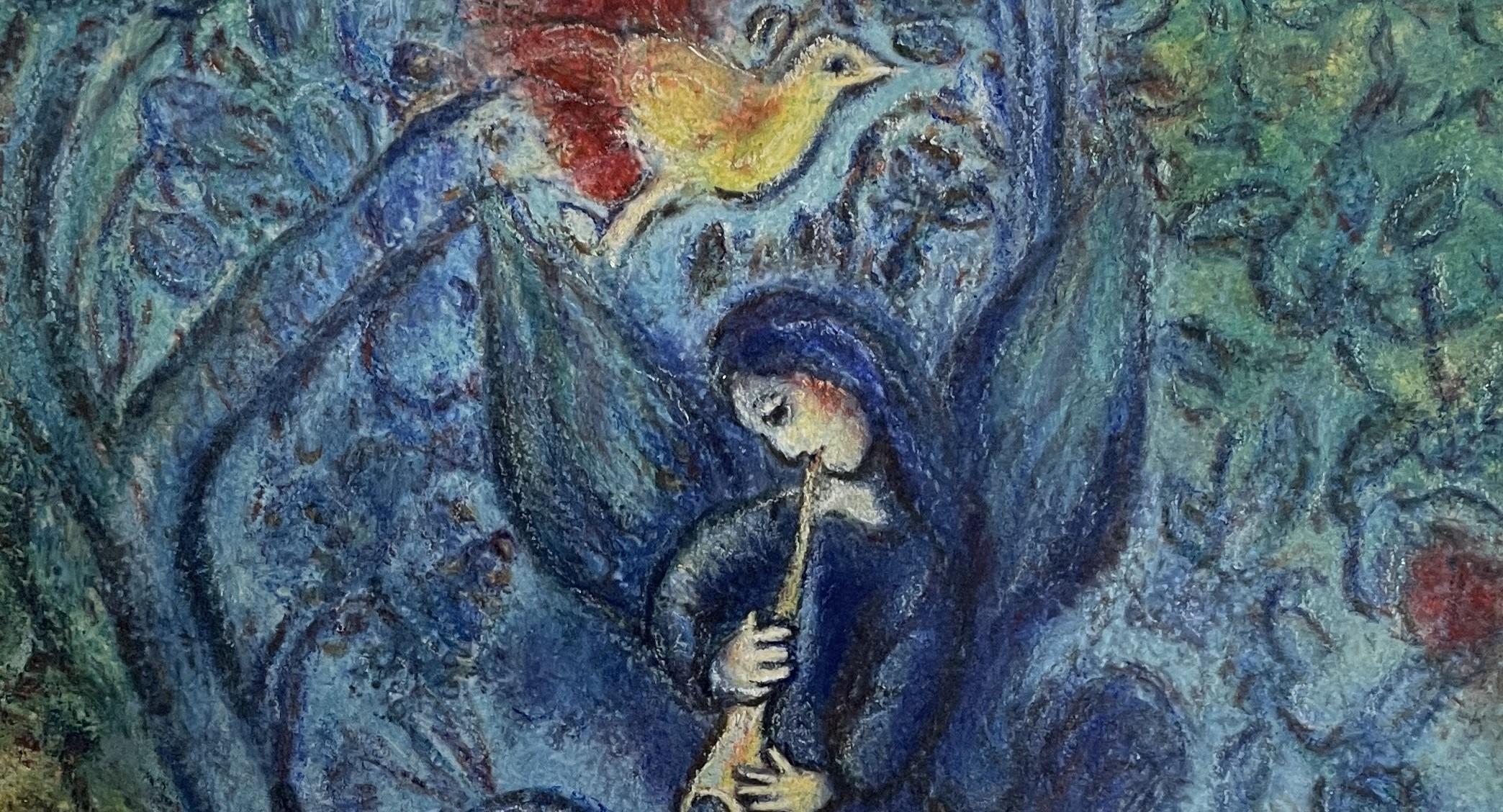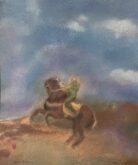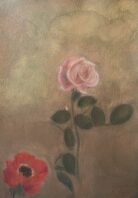日本語-Englishー台灣華語
オディロン・ルドン「花瓶のアネモネ」
芸術作品は生活上の出来事と決して無縁ではない。ルドンほど感受性が強い芸術家にあってはなおのことだ。幻想の画家と呼ばれるルドンは、心の動きを素直に表現した心優しい内気な芸術家だ。人間の顔を持つ花や蜘蛛といったルドンが産み落とした奇妙な怪物は、グロテスクであると言うよりはユーモラスでさえある。それは時に怖がりの子供が想像する自然観察の産物に似ている。ルドンは幼くして親元を離れて暮らしている。内気な性格も手伝って、少年時代の思い出は淋しい影となって心に沈殿したに違いない。ルドンが黒い絵を描いたのは、自分の心の奥底を吐き出すために必要だったのだ。孤独は深い洞察と夢想を育て、白と黒の世界を深化させ、後の色彩画家ルドンを育む下地となった。 結婚と子供の誕生を機に、ルドンは色彩画家に脱皮する。ルドンにとってカミーユは生命に溢れるミューズとなり、子供はルドンに生きる喜びを与えてくれる。孤独を乗り越え、遂に辿り着いた鮮やかな世界に、ルドンは心底安堵したに違いない。愛は色彩に現れるものだ。愛する女性がいないと花は描きにくいものだ。愛する人の肖像には思わず花を添えたくなるものなのだ。ルドンの詩的幻想の世界には、愛する気持ちが密やかに、そして素直に現れている。私はやはりルドンの花を描くことにする。
この「花瓶のアネモネ」は、人物画に添えられた花の絵に比べると写実的度合いが高い絵であるが、それでも独特の描法で描かれている。赤と紫の微妙に異なる花が随所に繰り返し配され、リズムを醸し出している。花と茎は必ずしも結びついていない。花の大きさに比較して背景が占める比率が極端に高い。原作は私が描いたよりも更に広い。この絵は空間的広がりをテーマとした絵に花が添えられていると言った方が適切である。ルドンは色彩によって何よりも空間的広がりを獲得したのだと私は思う。ルドンにとって花の絵は、絵画的幻想を生み出すきっかけを与えてくれるものなのかもしれない。
ルドンの幻想的絵画の魅力は、画家の気質に依存するというよりは、やはり特異な技法と効果に支えられている面が大きい。ルドンは見る者の想像を喚起するために、誰もが実際に知っているものを故意に避ける傾向にある。知っているものでも、知らないもののように描き出す。ルドンはこの世に存在しない架空の草花を創り出す。顕微鏡で覗き込んだ微生物や鉱物の文様が花に転化する。また伝統的技法をあえて避け、異質な絵画であることを視覚的に訴えている。ルドンの絵画は全体に空中に浮遊しているかのような印象を受ける。画面に描かれる人物や物は、立脚する地点があいまいなまま唐突に現れる。遠近法があえて無視された画面には、空間の奥行きが定かではない。色彩についても、神秘性を高める青系色を中心とした寒色が全体を覆い、暖色が散りばめられる傾向にある。空(あるいは海)と大地を象徴する青と茶の組み合わせの絵が多いように感じられる。微妙に異なる色が隣接して配され、それが独特の奥行きと、微妙な感情の起伏を感じさせる。
ルドンのタッチは独特で、あえて統一性を持たせないように配慮されている。画面には左から右から、時に上から下から描いた痕跡がそのまま残っている。まるで版画家が版木を回転させながら描いたようだ。全体に微細で短い平行線が縦横に駆使され、霞がかったように画面が揺れ動いている。ルドンの絵では油彩であってもこうしたパステルの描法が援用されている。ルドンは決して激高することのない、緻密で知的な画家なのである。
Anemones in a blue Vase
Artworks are never unrelated to the events of life, especially for an artist as sensitive as Odilon Redon. Known as a painter of fantasy, Redon was a kind and introverted artist who expressed the movements of his heart candidly. The strange monsters he created, such as flowers and spiders with human faces, are more humorous than grotesque. They resemble the products of natural observation imagined by a child prone to fear. Having lived away from his parents from a young age, Redon’s introverted nature likely caused his childhood memories to settle as lonely shadows in his heart. Redon’s creation of black paintings was necessary to release the depths of his own heart. Solitude nurtured deep insight and dreams, enriching the world of black and white and laying the foundation for Redon, the later colorist.
With marriage and the birth of his children, Redon transformed into a colorist. To him, Camille became a muse brimming with life, and his children brought him the joy of living. Overcoming loneliness, he must have felt truly relieved in the vivid world he finally reached. Love manifests in color. Without the love of a woman, it is difficult to paint flowers. One naturally wants to add flowers to the portrait of a loved one. In Redon’s poetic fantasy world, feelings of love appear secretly and honestly. I decide to paint Redon’s flowers.
“The Anemones in a Vase,” though more realistic than his paintings of flowers accompanying portraits, is still rendered in a distinctive technique. Red and purple flowers, subtly different, are placed throughout, creating rhythm. The flowers and stems are not always connected, and the background occupies an extremely high proportion compared to the size of the flowers. The original work is even broader than what I have painted. It would be more appropriate to say that flowers are added to a painting themed on spatial expansion. I think that above all, Redon achieved spatial expansion through color. For Redon, painting flowers might have been a way to spark pictorial fantasies.
The appeal of Redon’s fantastical paintings relies less on the artist’s temperament and more on his unique techniques and effects. Redon tends to avoid intentionally what everyone knows to evoke the viewer’s imagination, making the familiar appear unfamiliar. He creates imaginary flora that do not exist in this world, transforming microscopic organisms and mineral patterns observed under a microscope into flowers. He also deliberately avoids traditional techniques to visually assert the uniqueness of his paintings. Redon’s paintings give the impression of floating in the air, with characters and objects appearing abruptly without a clear footing. The perspective is intentionally ignored, leaving the depth of space uncertain. In terms of color, a predominance of cold, blue hues envelops the whole, enhancing the mystery, with warm colors scattered throughout. Many paintings seem to combine blue and brown, symbolizing sky (or sea) and earth, placed next to subtly different colors to create a unique depth and nuanced emotional fluctuations. Redon’s touch is unique, carefully avoiding uniformity. Marks of painting from left to right, sometimes from top to bottom, remain visible, reminiscent of a printmaker rotating the block while drawing. The entire surface is utilized with fine, short parallel lines, creating a trembling, misty effect. Even in oil paintings, Redon employs a pastel technique. He is a calm, meticulous, and intellectual painter.
歐迪隆·雷東「花瓶裡的鳶尾花」
藝術作品與生活中的事件從來不是無關的。對於像盧東這樣敏感的藝術家來說更是如此。被稱為幻想畫家的盧東,是一位坦誠表達內心動態的溫柔內向的藝術家。盧東創造的帶有人類面孔的花朵和蜘蛛等奇異怪物,與其說是怪誕,不如說甚至有點幽默。這些作品有時像是膽小的孩子對自然觀察的想像產物。盧東從小離開家庭生活,內向的性格使得童年的回憶成為心中寂寞的陰影。盧東之所以畫黑色的畫,是因為需要表達自己內心深處的感受。孤獨培養了深刻的洞察力和夢想,豐富了黑白世界,為後來成為彩色畫家的盧東奠定了基礎。
結婚和孩子的誕生使盧東轉變為彩色畫家。對盧東來說,卡米爾成為充滿生命力的繆斯,孩子給予了盧東生活的喜悅。克服孤獨,最終達到繽紛的世界,盧東必定感到了深深的安慰。愛在顏色中顯現,沒有愛的女性,花朵難以描繪。愛的人像旁自然想要添上花朵。盧東的詩意幻想世界中,愛的感覺隱秘而坦誠地展現。我決定還是畫盧東的花。
這幅「花瓶裡的鳶尾花」雖然是寫實度較高的畫作,與人物畫旁的花相比,但仍採用了獨特的繪畫方式。畫中隨處可見的紅色和紫色的花朵微妙不同,創造出節奏感。花朵和莖並不總是相連。與花朵大小相比,背景所占比例極端高。原作比我畫的更寬廣。這幅畫更適合說是以空間延伸為主題,花朵是附加上去的。我認為盧東通過顏色獲得了空間延伸感。對盧東來說,花的畫作可能是提供繪畫幻想的契機。
盧東的幻想畫魅力,不僅僅依賴於畫家的氣質,更多的是依靠獨特的技法和效果。盧東傾向於避免描繪所有人都實際知道的事物,以喚起觀者的想像。即使是熟悉的事物,也要畫得像是未知的。盧東創造了不存在於這個世界的虛構植物。透過顯微鏡觀察到的微生物和礦物的圖案轉化為花朵。他故意避免傳統技法,以視覺上呈現異質的畫面。盧東的畫給人一種整體漂浮在空中的印象。畫面中的人物和物體突然出現,站立點模糊不清。故意忽略透視法,畫面中空間深度不確定。在色彩上,寒色主要是增加神秘感的藍色系覆蓋全畫,暖色偶爾點綴其中。感覺到許多畫作是青色和棕色組合,象徵天空(或海)和大地。細微不同的顏色相鄰配置,創造獨特的深度和細膩的情感波動。盧東的筆觸獨特,刻意不追求一致性。畫面從各個方向描繪的痕跡明顯保留。就像版畫家轉動木板一樣畫畫。整體上細微的平行線橫豎使用,使畫面如霧般動搖。即使是油畫,盧東也借鑒了粉彩的畫法。盧東是一位從不急躁,細膩且智慧的畫家。





